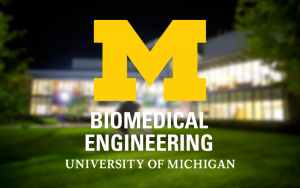Presented By: Biomedical Engineering
PhD Defense: William Y. Wang
Biomimetic Microsystems to Study Cell Migration Mechanoreciprocity in Health and Disease

Mechanoreciprocity in cell migration is an emerging concept describing the dynamic, bi-directional interactions between migrating cells and the surrounding extracellular matrix (ECM) they negotiate. Migrating cells not only sense and adapt to biochemical and biophysical ECM cues, but also, exert forces, deposit matrix, and secrete chemokines, matrix metalloproteinases, and matrix crosslinking enzymes that dynamically alter the same ECM properties known to regulate cell migration. Due to limitations in standard cell migration assays, how matrix properties influence cell migration and in turn, how cells influence matrix properties, has previously been studied as separate processes. However, observations from development, wound healing, and a variety of disease processes highlight the interdependency and iterative relationship between cell migration and ECM. An improved understanding of the underlying mechanisms that orchestrate the coevolution of migrating cells and ECM will aid in tissue engineering and regenerative medicine efforts to guide repair fibroblasts to regenerate wound beds, direct collective endothelial cell migration to vascularize ischemic or engineered tissue grafts and confine otherwise metastatic cancer cells to the primary tumor. Thus, the focus of this dissertation is to design biomimetic microsystems that afford investigation of cell migration mechanoreciprocity with a focus on fibroblasts, endothelial cells, and cancer cells.
First, this thesis investigated how single mesenchymal cells (fibroblasts and cancer cells) migrate in fibrous stromal tissue settings, such as in trans-stromal cancer cell migration during metastasis. To model fibrous stromal tissue, 3D fiber networks were electrospun over microfabricated wells to define ECM mechanics. Independently tuning alignment and stiffness of these matrices resulted in two phenotypically distinct cell migration modes. In contrast to stiff matrices where cells migrated continuously in a traditional mesenchymal fashion, cells in deformable matrices stretched matrix fibers to store elastic energy; subsequent adhesion failure triggered sudden matrix recoil and rapid cell translocation (termed slingshot migration). Across a variety of cell types, traction force measurements revealed a relationship between cell contractility and the matrix stiffness where slingshot migration mode occurred optimally.
Next, this thesis describes how microenvironmental cues influence collective endothelial cell migration during sprouting angiogenesis towards the design of pro-angiogenic biomaterials. This work employed a multiplexed angiogenesis-on-a-chip platform to assess the chemokine-directed 3D invasion of endothelial cells from a lumenized parent vessel into user-defined ECM. By tuning soluble and physical cues of the ECM, this work identified how 1) functional angiogenesis requires microenvironmental cues that balance cell invasion speed and proliferation; 2) dynamic interactions between sprout stalk cells and ECM regulates neovessel lumenization; and 3) imbuing microporosity within synthetic hydrogels can enhance endothelial cell invasion and angiogenic sprout lumenization.
Lastly, this thesis investigated how fibrous matrix cues activate quiescent vessel-lining endothelial cells into invasive tip cells in the context of fibrosis. Composite hydrogels (electrospun fiber segments suspended within 3D ECM) were integrated with the angiogenesis-on-a-chip platform. These studies establish that heightened matrix fiber density destabilizes cell-cell adherens junctions, reduces endothelium barrier function, and promotes the invasion of endothelial tip cells. Performing transcriptomic and secretomic analyses on fiber-induced tip endothelial cells revealed that fibrous ECM cues promote a fibrosis propagating phenotype.
Overall, the work presented in this dissertation integrates tunable biomaterials with microfabricated devices to investigate cell migration mechanoreciprocity of single mesenchymal cell migration, the collective migration of endothelial cells during angiogenesis, and endothelial-mesenchymal transition of quiescent endothelial cells into a fibrosis propagating cell phenotype.
Date: Friday, June 4, 2021
Time: 12:30 PM
Zoom: https://umich.zoom.us/meeting/register/tJcsf-uhpj4vGtyM7x-td2VV39BzqmF_zoob (Zoom link requires prior registration)
Chair: Dr. Brendon Baker
First, this thesis investigated how single mesenchymal cells (fibroblasts and cancer cells) migrate in fibrous stromal tissue settings, such as in trans-stromal cancer cell migration during metastasis. To model fibrous stromal tissue, 3D fiber networks were electrospun over microfabricated wells to define ECM mechanics. Independently tuning alignment and stiffness of these matrices resulted in two phenotypically distinct cell migration modes. In contrast to stiff matrices where cells migrated continuously in a traditional mesenchymal fashion, cells in deformable matrices stretched matrix fibers to store elastic energy; subsequent adhesion failure triggered sudden matrix recoil and rapid cell translocation (termed slingshot migration). Across a variety of cell types, traction force measurements revealed a relationship between cell contractility and the matrix stiffness where slingshot migration mode occurred optimally.
Next, this thesis describes how microenvironmental cues influence collective endothelial cell migration during sprouting angiogenesis towards the design of pro-angiogenic biomaterials. This work employed a multiplexed angiogenesis-on-a-chip platform to assess the chemokine-directed 3D invasion of endothelial cells from a lumenized parent vessel into user-defined ECM. By tuning soluble and physical cues of the ECM, this work identified how 1) functional angiogenesis requires microenvironmental cues that balance cell invasion speed and proliferation; 2) dynamic interactions between sprout stalk cells and ECM regulates neovessel lumenization; and 3) imbuing microporosity within synthetic hydrogels can enhance endothelial cell invasion and angiogenic sprout lumenization.
Lastly, this thesis investigated how fibrous matrix cues activate quiescent vessel-lining endothelial cells into invasive tip cells in the context of fibrosis. Composite hydrogels (electrospun fiber segments suspended within 3D ECM) were integrated with the angiogenesis-on-a-chip platform. These studies establish that heightened matrix fiber density destabilizes cell-cell adherens junctions, reduces endothelium barrier function, and promotes the invasion of endothelial tip cells. Performing transcriptomic and secretomic analyses on fiber-induced tip endothelial cells revealed that fibrous ECM cues promote a fibrosis propagating phenotype.
Overall, the work presented in this dissertation integrates tunable biomaterials with microfabricated devices to investigate cell migration mechanoreciprocity of single mesenchymal cell migration, the collective migration of endothelial cells during angiogenesis, and endothelial-mesenchymal transition of quiescent endothelial cells into a fibrosis propagating cell phenotype.
Date: Friday, June 4, 2021
Time: 12:30 PM
Zoom: https://umich.zoom.us/meeting/register/tJcsf-uhpj4vGtyM7x-td2VV39BzqmF_zoob (Zoom link requires prior registration)
Chair: Dr. Brendon Baker